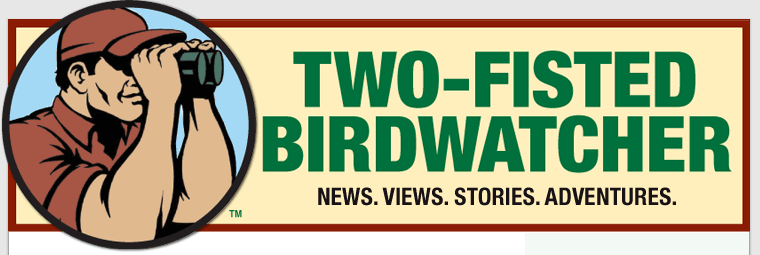Some wise dude once said: “The itch to travel is partly an itch to live in a different bird book, somebody else’s field guide.”
Okay, that dude was me. In “Itch Vs. Twitch,” one of these Daily Sightings pieces.
Hey, if you can’t quote yourself, maybe you’re not saying much. All that aside, those words came to mind again today…
A package with exotic markings arrived. Inside, was my new copy of “The Birds of Australia, Eighth Edition,” by Ken Simpson and Nicolas Day, with Peter Trusler.
This is from Princeton Field Guides, another example of their fine work. If you want to travel vicariously by “living in somebody else’s bird book,” here’s your ticket.
The birds in this book look familiar at first. But just wait.
You know you’re in for a ride from the opening pages. They don’t start with boring sea birds the way our guides do. This book opens with giants that waddled out of the Dr. Seuss department. Then you get the boring sea birds.
But boring’s the wrong word when talking about Australia. The country’s birds are a Star Trek episode.
Remember how characters on the Enterprise looked human until you got close? Whoa, that guy’s forehead has bony plates. She’s got three nostrils. Somebody’s blue.
They weren’t all humans on that starship. Some were humanoids. And the birds of Austalia? An American might call them bird-oids.
That’s not what hard core ornithologists would say. These guys know Australian birds, and won’t be fazed by their strangeness. Ornithology geeks will be wowed about the updating of rare species, the changes in taxonomy, the “Vagrant Bird Bulletin.”
But America’s two-fisted birdwatchers who are NOT ornithologists will read this new field guide like a sci-fi novel.
Up front, there’s a color map of Australia showing that it’s a round continent, give or take a few pointy parts. The image of a globe cannot be denied.
You’re looking at Planet Australia. And there will be bird-oids down there.
Flip to any page. The birds might at first look somewhat similar to those in American books. But, look closer. That crane’s not exactly a crane; it’s a “Brolga.” Looks, like a crane, walks like a crane…but:
“Brolga.”
Flip further into the book. Is that a page of thrushes? Wait; they’re not like any thrushes you know. There’s a “Cinnamon Quail Thrush.” A whole new model, with a whole new color scheme.
Flip some more. The “Red-Capped Robin” is designed by an artist who doesn’t exhibit in your home town.
And for us ordinary bird watchers, the oddities just keep coming: There are Pittas, Sittellas, Pardalotes, Logrunners; a Chowchilla, a Drongo, and Figbirds.
There are Flowerpeckers and Australo-Papuan Babblers. Spinebills. And Magpies that don’t look like Magpies. Crow-like “un-crows” that are called Currawongs. And what Australia doesn’t have in the way of woodpeckers, it makes up for with parrots.
There are almost 400 pages, 780 odd birds. Literally. With maps, charts, checklists, scholarly text sections and useful tips.
A trip to Planet Australia. The only thing better than going through this book would be going through this country. (You could talk to a guy named Steve Davidson, at the Melbourne Birder, about that.)
Meanwhile, a little armchair birding is always fun. This guide to planet Australia makes it exotic fun.

Sounds like a planet I would love to visit!
I love your “live in a different bird book” phrase, obviously 🙂
I always love reading your posts – they are worthy of a lol….
Glad you liked the book so well.
Marj,
Thanks for the comment and for the link to your site. Great photos.
Love reading your posts – you might enjoy a peek at the fairywrens that are very visible at the moment in my bit of Australia:
http://bushbirds.blogspot.com/2010/08/shortland.html
Interesting birds, though they form permanent pairs the females will sneak away while the male is proclaiming his territory for a liaison with lesser, younger males. They are also one of the few birds that recognise a cuckoos egg and turf it out of the nest.